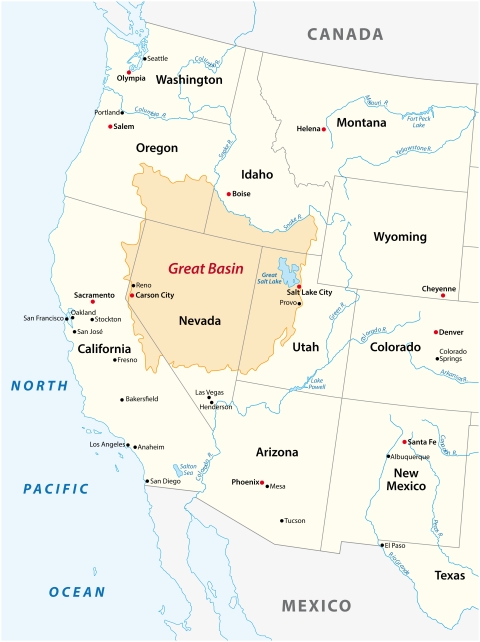The Great Basin extends from the edge of the Eastern Sierra Nevada to central Utah. The Great Basin includes parts of California, Oregon, Utah, Idaho, and most of Nevada. This landscape conjures images of vast, mountainous, and desolate landscapes. While sagebrush sagebrush
The western United States’ sagebrush country encompasses over 175 million acres of public and private lands. The sagebrush landscape provides many benefits to our rural economies and communities, and it serves as crucial habitat for a diversity of wildlife, including the iconic greater sage-grouse and over 350 other species.
Learn more about sagebrush is the dominant plant in the Great Basin, this ecosystem is also home to many other unique native plants that are each deserving of the spotlight. Read on to learn about some of the native plants that call the Great Basin home!
Plants Mentioned:
- Fish Slough milkvetch (Astragalus lentiginosus var. piscinensis)
- Webber’s ivesia (Ivesia webberi)
- Great Basin bristlecone pine (Pinus longaeva)
- Big sagebrush (Artemisia tridentata)
Fish Slough milkvetch
Fish Slough milkvetch is a member of the pea family. It grows along a 10-mile stretch along the Fish Slough near Bishop, CA, and let me tell you, this place is hot! Summer surveys for the plant take place in July when the species is flowering and daily highs average over 100 degrees Fahrenheit! With plenty of water and salty snacks, biologists spend a full week in the slough to monitor this federally listed plant.
Fish Slough milkvetch has long spindly stems that can grow up to three feet long. If you’re reading this and aren’t afraid of getting asked some questions by people around you, stick out your arm and envision a green stem that starts from your chest and stretches past your fingertips. That will give you an idea of the length of this plant. Along its stems, vibrant purple flowers bloom and subtly stand out in the desert landscape. After these flowers are pollinated, they form speckled seed pods, that once mature, dry and split open releasing seeds that can be dispersed to germinate and grow new Fish Slough milkvetch plants. Visit this link to see more photos of Fish Slough milkvetch.
Visit Fish Slough milk vetch with our It's Out Here!video series to get a deeper dive into this rare plant.
Webber’s ivesia
Webber’s ivesia is a member of the rose family that grows along the transition line between the western Great Basin, and northeastern Sierra Nevada. It is a low growing, perennial forb that is easy to miss even when looking for it because it blooms with many other yellow flowered native species! However, it’s yellow flowers are accompanied by red, wiry stems. Reno is the closest city and just saying that might be an understatement because its population center is Peavine Mountain, in the heart of Reno!
Webber’s ivesia grows on seasonally wet, shallow soils of clay that shrinks and swells as winter gives way to spring. The plant blooms in early spring and sets its seed by early summer. When it finishes reproduction, it retreats to its root to “hibernate” during the cold weather, and once late spring rolls around, it pops out with a flourish of yellow, five petaled flowers. Discovering a field of Webber’s ivesia can be quite the site to see! Visit this link to see more photos of Webber's ivesia.
Sagebrush
Sagebrush species, including Big sagebrush, dominate the landscape across the Great Basin. If you have ever stepped foot in Northern Nevada, you will no doubt be familiar with the “Sagebrush Sea.” However, you may be less familiar with this plant's important role in the ecosystem. Sagebrush provides food and habitat for a variety of animal species, such as the Greater Sage-Grouse, sage thrasher, sage sparrow, pronghorn, mule deer, and pygmy rabbits.
Big sagebrush derives its botanical name, Artemisia tridentata, from its three (tri) lobed or toothed leaves (dentata). The species is generally long-lived and can reach over 100 years old! Big sagebrush has a strong pungent fragrance, especially when wet. Walking among sagebrush after a rainstorm is highly recommended! Sagebrush is an emblem of Nevada, where it is the official state flower, is featured on the state flag, and is even mentioned in the state song!
Sagebrush appreciation plug:
The sagebrush ecosystem provides great opportunities for nature watching! The wide-open expanses of the Sagebrush Sea provide visitors with ample opportunity to watch hawks soar through the sky, pronghorn sprint through the shrubs, and take in a world that is teeming with life, all while getting away from busy crowds and noisy streets. In Nevada, Sheldon National Wildlife Refuge is a great option to take in a near pristine sagebrush ecosystem.
Bristlecone Pine
Saying Great Basin bristlecone pines are hardy would be an understatement. They live in dry areas, at high elevations, endure staggering winds and cold winters at 10,000 feet elevation, and are one of the oldest living organisms on the planet! Shaped by the wind, they are twisted and gnarled, both beautiful and rugged, and these trees personify the word ‘ancient’.
Because of these conditions, Great Basin bristlecone pine trees grow very slowly, in some years they don't even add a ring of growth! The oldest recorded tree is estimated to be over 5,000 years old; a lot has happened in this time! This species has (figuratively) seen the Great Pyramids of Giza get built, was in its adolescence when Rome was just getting started, and it began growing right around the time when the written word was invented! If you are driving along the Eastern Sierra, you will pass by a sign in Big Pine, CA that will point you in the direction of the Ancient Bristlecone Pine Forest. You can also see these ancient trees in Nevada by making a trip to Great Basin National Park. It is worthwhile to make the drive to see trees twenty times older than the United States of America!









